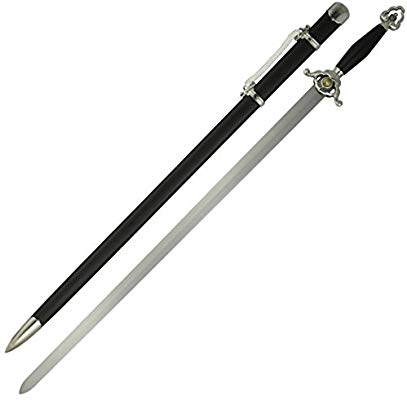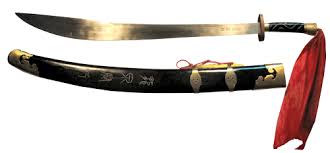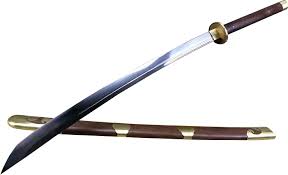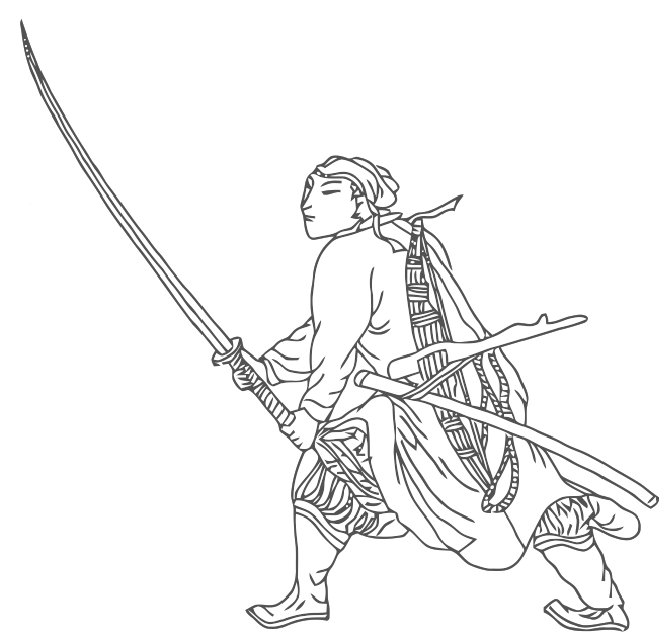The study of weapons in martial arts serves as a valuable supplement to empty-hand techniques, It enhances practitioners’ understanding of body mechanics, cultivates specific abilities associated with different weapons.
Jian
The Tai Chi straight double edged Sword ‘the Jian’ which not only develops the ability to use the sword but promotes strength, extends the chi to the tip of the sword thus the concept of projection is further refined. In accordance with the principles of Tai Chi the sword practice is an exercise for good health and meditation in motion as well as a method of self-defence. The postures of the sword form are soft, flowing on the outside with inner core strengthening on the inside. The sinews, tendons and joints are developed through the choreography as too is muscle tone. Body balance is increased as the sword is extended outwards from the body; stances too are also further developed as a result of this extension. Through its practise the sword form covers a wide range of angles and directions with twist and turns utilising cut; thrust, stab and slice. The sword practitioner through use of angles and foot work will gain the necessary agility and traction to root through the feet when required and move light also when needed. The focusing of the mind and spirt, practised with a calm yet lively attitude will have the effect on the body with a sense of control and wellbeing. The Sword form also reinforces the concepts and principles within the empty hand form as the concept of stick is also the method of the swords use,’ first stick then strike ‘

The Broad Sword ‘Dao’’
Single Edged, Curved, Chinese Broadsword With fa-jing movements, leaps and jumps, this form will balance you internally and for fitness, there is nothing finer as it works every muscle and sinew in the body. This sword form utilises a heaver weapon which further strengthens the body through the use of thrust, stab, cut, slice and chop. The weight of the sword, with fast movements coupled with spins develops physical fitness, wrist strength, and flexibility, especially to the joints of the upper body is trained. Being a much heavier sword the students learns the concept of body and footwork to control this weapon rather than swinging the arm, thus linking footwork to body and body to arm and finally arm to sword. There is a lesson in body mechanics and is the reason for its study and will have a profound effect on the understanding of forces applied. The whole form is performed in a strong yet flowing unbroken ebb and flow of swirls and turns with good posture and power with complete control. The form is practised a little faster than the empty hand form but again speed is a matter of preference and the student should consider all speeds. Relaxation is a requirement to execute this form as the practitioner utilises centrifugal and centripetal force issued from the inner core directed by the mind to control the broad sword.

Miao Dao
The Miao Dao is a very long Chinese two handed dao sword which originated in China by General Qi Jiguang. The long double handed sword was used by the Generals soldiers to counter against the samurai sword. This Miaodao has a strong resemblance to the Tai Chi Dao but it is much longer. Chinese
This Miao Dao blade made of Stainless Steel has a mirror polished finish. The blade is very stiff. The Miao Dao is crafted with thick semi rounded spine to increase its rigidity. The “S” shaped guard, pommel, and fittings are constructed of brass. The handle and scabbard are made of hardwood with a fine lacquer finish.
The mentioning of the Miao Dao brings to mind General Qi Jiguang and his efforts in warding of pirates, or Wokou, from China’s east coast during the mid-1500s period. The pirates were not easily defeated. Qi Jiguang analysed their tactics, weapons and fighting methods and took several years to create winning strategies, one of which is the use of a double-handed long blade to counter the pirate’s samurai swords. Qi Jiguang later updated the documented strategies initially published in 1560 – to include adding two chapters to the original eighteen. Probably the first manual in the history of China on fighting with a double-handed long blade, many practitioners of modern Miao Dao (苗刀) regard Qi Jiquang’s as the origin and source of their art.
The Miao Dao is characterised by its long blade and long handle, often exceeding 1.2m in total. With its length, the Miao Dao is a versatile weapon with good effective range, which can be achieved through a series of single and double hand movement and techniques.
Due to the double handed movements, the forms related to the Miao Dao are often mistaken to present techniques related to Japanese swordsmanship. In fact the resemblance between the Miao Dao and the Japanese sword (Nodachi/Tachi/Katana) techniques is the result of cultural exchanges spanning almost a thousand years. In the Tang period (618 to 907) large quantities of Chinese long swords made its way to Japan, and during the Ming period (1368 to 1644) similar amounts of Japanese swords were imported to China.
The picture below shows a typical Miao Dao available in the market today. The total length is 1.4m, with a handle and blade length of 0.4m and 1m respectively. The blade is made of high carbon steel and the handle and scabbard are made from quality redwood. When held without the scabbard, it weighs about 1.2 kg.

Along with the different periods of Chinese History, the Miao Dao took on slightly different forms and name, but its function and length remains largely the same. In the Han (206BC to 220AD) and Ming periods, it is called Chang Dao and the term Miao Dao only came about in the early republican period. The reason for this emergence cannot be confirmed but we know of several speculations including those associating Miao Dao to the Miao ethnic minority in China, or to the Miao mountain , or to the shape of the grain leaf, or to certain martial arts novel in the pre-republican period where this term was first written.
Why study weapons?
The study of weapons in martial arts serves as a valuable supplement to empty-hand techniques. It enhances practitioners’ understanding of body mechanics, cultivates specific abilities associated with different weapons, and contributes to the overall development of strength, power, and agility in motion. The optional nature of weapons learning provides practitioners with the freedom to tailor their training experience to align with their interests and aspirations.
As with all the weapons in the Shizendo curriculum they are optional to learn.
